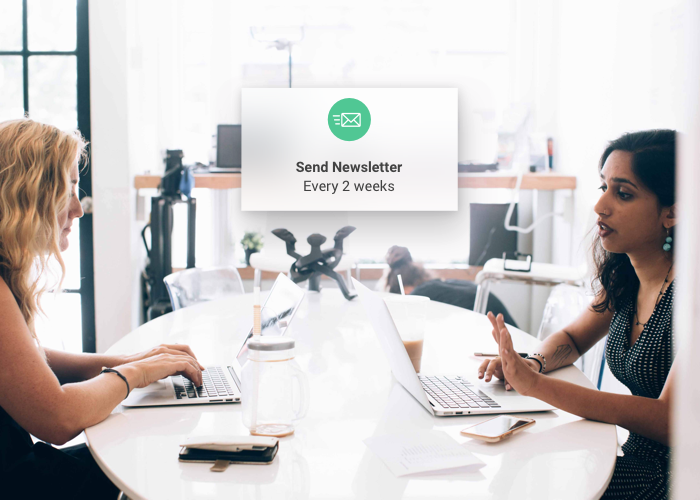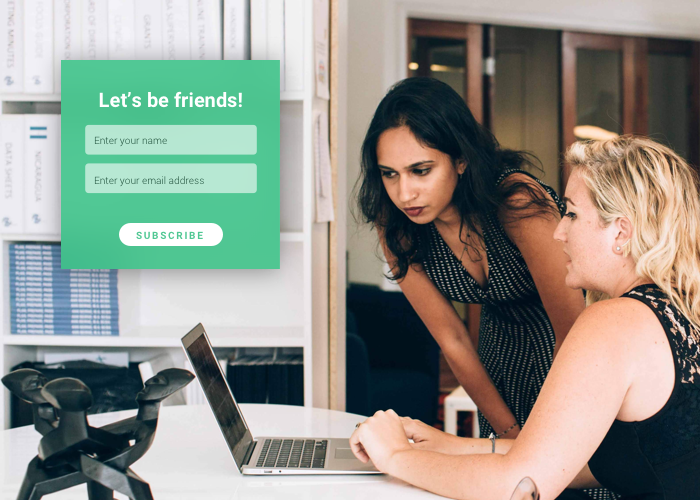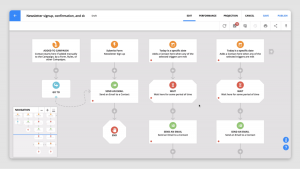In a study by the Reuters Institute, researchers found that 73% of their sample were signed up for interest-based email lists, indicating that customers are still widely receptive to recurring email content strategies. Newsletters are a great way for businesses to stay top-of-mind with clients who have shown interest in their product — and you can implement one in your business too.
Why invest in newsletter campaigns?
Marketing through newsletters is a strategic way to increase touch points and build relationships with your contacts. Online correspondence is a powerful tool and, according to Twilio’s Consumer Engagement study, 83% of consumers prefer email as the primary channel to receive messages from businesses. Unlike social media posts that disappear over time, newsletters sit in your contacts’ inboxes waiting to be opened.
Content marketing newsletters are a win-win. You get clicks, views and overall boosted performance, and your contacts get relevant and helpful information delivered right to their inboxes.
Putting together a successful newsletter campaign, however, isn’t as easy as throwing together some content and pressing send. You’ve also got the responsibility of making sure each message is strategic and provides sufficient value. Every message should go through an iterative testing process and be sent out to subscribers with impeccable timing. Here are the steps to creating an effective newsletter campaign:

Plan send frequency around your content
When determining the frequency of your newsletter, consider how much content your brand produces and news it has to share. With multiple releases per week, it’s worth your time to use a weekly newsletter to get eyes on it. Otherwise, a monthly newsletter might be a better fit.
To take advantage of the lead nurturing benefits of newsletters, you can work both a weekly and monthly newsletter into your strategy, if you have the resources to do so. For example, let’s say you’re a lifestyle coach and you create two new videos and articles per week. You could send your newest content in a newsletter every Monday and, at the beginning of each month, send an email with only your top-performing pieces of content from the previous month.
Word to the wise: Keep promotional content in your newsletters to a minimum. The more you stick to valuable content for subscribers, the more likely they are to open your emails.

Build your newsletter subscriber list
Email marketing yields a high ROI — every dollar you spend has the potential to bring you a $44 return. Your newsletter campaign’s success is scalable, so constantly growing your subscriber list is a great way to bring in more sales over time. There are many effective ways to do this, including:
- Adding Opt-in forms to your site’s pages
- Setting up Pop-ups to display on exit intent or after spending a certain amount of time on a page
- Writing social media posts that promote subscribing to your newsletter
Welcome and thank new subscribers
As subscribers opt in for your newsletter, let them know their sign-up was successful with a welcome email that thanks them for subscribing and introduces them to your brand.
This email is a one-time message with short copy that builds trust and shows your subscribers that they’ve been added to your campaign, and you’re glad they’ve joined your community.
Pick a consistent date and time
To create a sense of consistency for both you and your list, it’s important to find a specific day of the week and time of day when your newsletter arrives in your subscribers’ inboxes. Because the best send time can differ depending on your audience, industry and type of content, try split testing until you find a winning combination. Split testing is a process where you pit two versions of your newsletter against one another to see which performs better. For example, you can send your newsletter at different times — Monday at 12 P.M. and Wednesday at 1 P.M. — to various portions of your audience, and use your results to determine an optimal sending schedule.
To keep the time consistent across your list, use your email service provider system to set a send time specific to the contacts’ time zones so that a message scheduled at 11 A.M. PT, for example, doesn’t deliver at 1 P.M. ET to your New York subscribers.
Once you find a date and time combination that works, you can use it as a control for future copy and design split testing. To have an accurate measure of how well your email copy and design are doing, you should be able to rule out date and time as a factor.
Set tracking goals that encourage success
Your newsletter campaign is not complete without a way to measure success. Set SMART (specific, measurable, achievable, relevant and timely) goals that align with your overall business goals. If you keep these in mind when looking at your data, you’ll better understand the effectiveness of your newsletter campaign.
To make sure you’re creating SMART goals, ask yourself:
- Why am I sending out these newsletter emails in the first place?
- What do I hope to gain from them?
- If I don’t achieve that goal with these emails, are they still a success?
Here are a few metrics you may want to use:
Chances are, your ultimate goal is to generate sales and revenue with your newsletter campaign. If that’s the case, you’ll want to focus on conversions rather than email opens or clicks.
With your email tracking tool, you can check your campaign numbers. As you learn which types of copy and design perform best, you can optimize future messages.
Maintain your newsletter campaigns over time
To avoid your newsletter getting sidelined to the spam box and losing subscribers, do regular maintenance on your campaign. In addition to testing and optimizing your emails, ensure they’re getting into active inboxes. Over time, your subscribers may shut down or abandon their email addresses, making your messages undeliverable. If you have too many undeliverable emails, ISPs will start treating you as if you’re a spammer, and your newsletter will be diverted. This creates a self-perpetuating cycle of falling open and deliverability rates that trigger spam filters. It may be helpful to use an email verification service which can tell you whether your subscribers’ email addresses are accurate and valid. Maintaining the hygiene of your subscriber list in this way is known as cleaning.
Another way to maintain your newsletter list is by trimming contacts who haven’t recently engaged with your messages. By scheduling a list cleaning once or twice a year, your emails will be sent to a curated list of interested contacts who are more likely to have active addresses.
Launch an effective newsletter campaign by following these steps:
- Specify the frequency of your newsletter delivery.
- Plan the ways contacts can be added to your list.
- Send a one-time confirmation email to new subscribers.
- Set a consistent send time that is sensitive to the contacts’ time zones.
- Split test each message to optimize your campaign over time.
- Set SMART goals that result in success.
- Clean your subscriber list to ensure your newsletter lands in your subscribers’ inboxes.
Once you add these seven best practices to your newsletter strategy, you’ll be able to plan and map your weekly or monthly newsletter campaign and get started. Here’s an idea of what your completed campaign map will look like:

If you have an Ontraport account, you can find a templated version of this campaign called “Newsletter signup, confirmation and delivery” and fill in each step. It’s that simple, and we’re always here if you need help with your email newsletter campaign!
